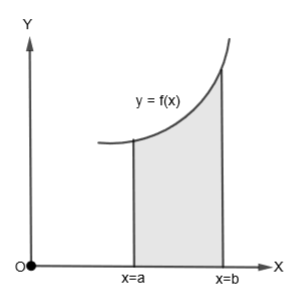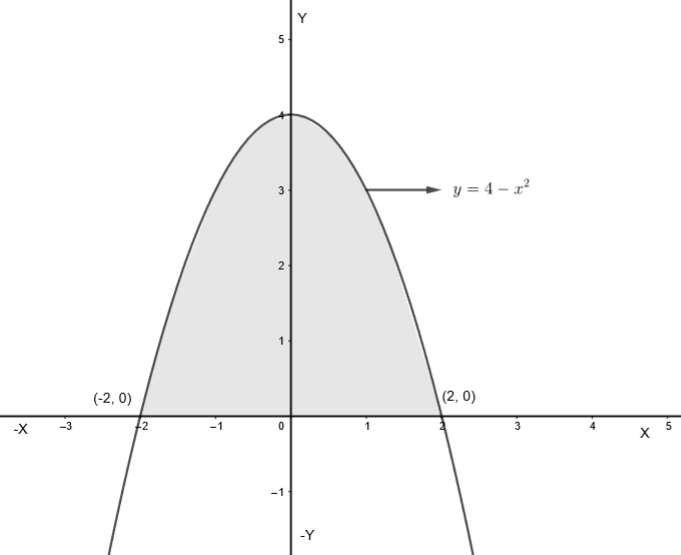
The area bounded by the parabola \[y=4-{{x}^{2}}\] and x-axis in sq. units is:
(a) \[\dfrac{32}{3}\]
(b) \[\dfrac{16}{3}\]
(c) \[\dfrac{8}{3}\]
(d) \[\dfrac{1}{3}\]
Answer
592.5k+ views
Hint: First of all, draw the curve in x – y plane to visualize the question. Now, find the points at which it is the intersection at x-axis by substituting y = 0 in the curve. Suppose the points are a and b. So, find the required area by evaluating the integral \[\int\limits_{a}^{b}{ydx}\]. Here, substitute the value of y as \[\left( 4-{{x}^{2}} \right)\] and use \[\int{{{x}^{n}}dx}=\dfrac{{{x}^{n+1}}}{n+1}\].
Complete step-by-step answer:
In this question, we have to find the area bounded by the parabola \[y=4-{{x}^{2}}\] and x-axis in square units. Let us first see the area bounded by any curve y = f (x) and the x-axis. So, we get the area bounded by the curve y = f (x), the axis and the ordinates x = a and x = b is given by
\[A=\int\limits_{a}^{b}{f\left( x \right)}dx=\int\limits_{a}^{b}{ydx}\]

Let us now consider our question. Let us draw the curve \[y=4-{{x}^{2}}\] in the x – y plane.

By substituting y = 0, we get,
\[0=4-{{x}^{2}}\]
\[{{x}^{2}}=4\]
\[x=\pm \sqrt{4}\]
\[x=\pm 2\]
So, the curve cuts the x-axis at (2, 0) and (– 2, 0).
So, we get the area enclosed between the curve x-axis and ordinates x = – 2 and x = 2, we get,
\[A=\int\limits_{a}^{b}{f\left( x \right)dx}\]
\[A=\int\limits_{-2}^{2}{\left( 4-{{x}^{2}} \right)dx}\]
We know that,
\[\int{{{x}^{n}}dx}=\dfrac{{{x}^{n+1}}}{n+1}+c\]
So, we get,
\[A=\int\limits_{-2}^{2}{\left( 4{{x}^{0}}-{{x}^{2}} \right)dx}\]
\[A=\int\limits_{-2}^{2}{\left( \dfrac{4{{x}^{0+1}}}{0+1} \right)-\left( \dfrac{{{x}^{2+1}}}{2+1} \right)}\]
\[A=\int\limits_{-2}^{2}{\left( 4x-\dfrac{{{x}^{3}}}{3} \right)}\]
By substituting the limits in the above expression, we get,
\[A=\left[ \left( 4\left( 2 \right)-\dfrac{{{\left( 2 \right)}^{3}}}{3} \right)-\left( 4\left( -2 \right)-\dfrac{{{\left( -2 \right)}^{3}}}{3} \right) \right]\]
\[A=\left[ \left( 8-\dfrac{8}{3} \right)-\left( -8+\dfrac{8}{3} \right) \right]\]
\[A=\left[ \left( \dfrac{16}{3} \right)-\left( \dfrac{-16}{3} \right) \right]\]
\[A=\dfrac{32}{3}sq.units\]
So, option (a) is the right answer.
Note: In this question, many students make this mistake of finding the area between x = 0 and x = 2 but forget to double it and get the wrong answer as (b). So, they must take care that we need to find the area between the ordinates x = – 2 and x = 2. Also, students must note that whenever we find the area under the curve, we always have to take the modulus of it in case it is negative because the area can never be a negative value.
Complete step-by-step answer:
In this question, we have to find the area bounded by the parabola \[y=4-{{x}^{2}}\] and x-axis in square units. Let us first see the area bounded by any curve y = f (x) and the x-axis. So, we get the area bounded by the curve y = f (x), the axis and the ordinates x = a and x = b is given by
\[A=\int\limits_{a}^{b}{f\left( x \right)}dx=\int\limits_{a}^{b}{ydx}\]

Let us now consider our question. Let us draw the curve \[y=4-{{x}^{2}}\] in the x – y plane.

By substituting y = 0, we get,
\[0=4-{{x}^{2}}\]
\[{{x}^{2}}=4\]
\[x=\pm \sqrt{4}\]
\[x=\pm 2\]
So, the curve cuts the x-axis at (2, 0) and (– 2, 0).
So, we get the area enclosed between the curve x-axis and ordinates x = – 2 and x = 2, we get,
\[A=\int\limits_{a}^{b}{f\left( x \right)dx}\]
\[A=\int\limits_{-2}^{2}{\left( 4-{{x}^{2}} \right)dx}\]
We know that,
\[\int{{{x}^{n}}dx}=\dfrac{{{x}^{n+1}}}{n+1}+c\]
So, we get,
\[A=\int\limits_{-2}^{2}{\left( 4{{x}^{0}}-{{x}^{2}} \right)dx}\]
\[A=\int\limits_{-2}^{2}{\left( \dfrac{4{{x}^{0+1}}}{0+1} \right)-\left( \dfrac{{{x}^{2+1}}}{2+1} \right)}\]
\[A=\int\limits_{-2}^{2}{\left( 4x-\dfrac{{{x}^{3}}}{3} \right)}\]
By substituting the limits in the above expression, we get,
\[A=\left[ \left( 4\left( 2 \right)-\dfrac{{{\left( 2 \right)}^{3}}}{3} \right)-\left( 4\left( -2 \right)-\dfrac{{{\left( -2 \right)}^{3}}}{3} \right) \right]\]
\[A=\left[ \left( 8-\dfrac{8}{3} \right)-\left( -8+\dfrac{8}{3} \right) \right]\]
\[A=\left[ \left( \dfrac{16}{3} \right)-\left( \dfrac{-16}{3} \right) \right]\]
\[A=\dfrac{32}{3}sq.units\]
So, option (a) is the right answer.
Note: In this question, many students make this mistake of finding the area between x = 0 and x = 2 but forget to double it and get the wrong answer as (b). So, they must take care that we need to find the area between the ordinates x = – 2 and x = 2. Also, students must note that whenever we find the area under the curve, we always have to take the modulus of it in case it is negative because the area can never be a negative value.
Recently Updated Pages
Master Class 12 English: Engaging Questions & Answers for Success

Master Class 12 Business Studies: Engaging Questions & Answers for Success

Master Class 12 Economics: Engaging Questions & Answers for Success

Master Class 12 Social Science: Engaging Questions & Answers for Success

Master Class 12 Maths: Engaging Questions & Answers for Success

Master Class 12 Chemistry: Engaging Questions & Answers for Success

Trending doubts
What are the major means of transport Explain each class 12 social science CBSE

Which are the Top 10 Largest Countries of the World?

Draw a labelled sketch of the human eye class 12 physics CBSE

Explain sex determination in humans with line diag class 12 biology CBSE

The pH of the pancreatic juice is A 64 B 86 C 120 D class 12 biology CBSE

Explain sex determination in humans with the help of class 12 biology CBSE




